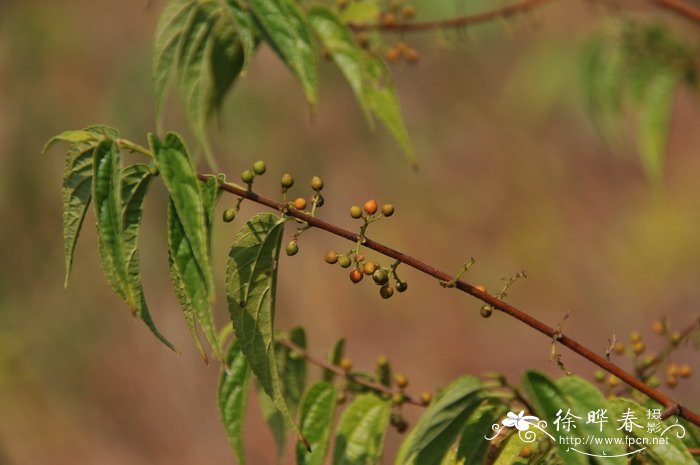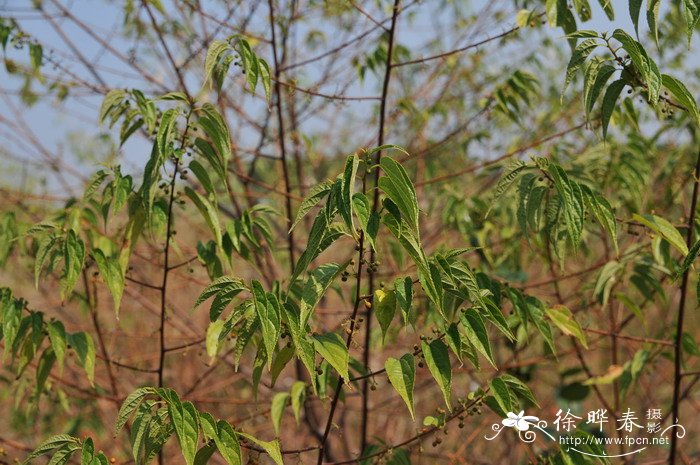山黄麻Trema tomentosa
中文名(Chinese Name):山黄麻
学名(Scientific Name):Trema tomentosa (Roxb.) Hara
英文名(English Common Name):
别名(Chinese Common Name):山麻、麻桐树
异名(Synonym):Trema dunniana H. Lév. Sponia velutina Planch. Sponia amboinensis (Wall.) Decne. Trema amboinensis (Willd.) Blume Sponia tomentosa (Roxb.) Planch. Trema velutina (Planch.) Blume Celtis amboinensis Willd. Celtis tomentosa Roxb.
科属(Family & Genus):榆科(Ulmaceae)山黄麻属
形态特征(Description):小乔木,高达10米,或灌木;树皮灰褐色,平滑或细龟裂;小枝灰褐至棕褐色,密被直立或斜展的灰褐色或灰色短绒毛。叶纸质或薄革质,宽卵形或卵状矩圆形,稀宽披针形,长7-15 (-20) 厘米,宽3-7 (-8) 厘米,先端渐尖至尾状渐尖,稀锐尖,基部心形,明显偏斜,边缘有细锯齿,两面近于同色,干时常灰褐色至棕褐色,叶面极粗糙,有直立的基部膨大的硬毛,叶背有密或较稀疏直立的或稀斜展的灰褐色或灰色短绒毛(茸毛),有时稀疏地混生褐红色(干时)串珠毛,基出脉3,侧生的一对达叶片中上部,侧脉4-5对;叶柄长7-18毫米,毛被同幼枝;托叶条状披针形,长6-9毫米。雄花序长2-4.5厘米,毛被同幼枝;雄花直径1.5-2毫米,几乎无梗,花被片5,卵状矩圆形,外面被微毛,边缘有缘毛,雄蕊5,退化雌蕊倒卵状矩圆形,压扁,透明,在其基部有一环细曲柔毛。雌花序长1-2厘米;雌花具短梗,在果时增长,花被片5-4,三角状卵形,长1-1.5毫米,外面疏生细毛,在中肋上密生短粗毛,子房无毛;小苞片卵形,长约1毫米,具缘毛,在背面中肋上有细毛。核果宽卵珠状,压扁,直径2-3毫米,表面无毛,成熟时具不规则的蜂窝状皱纹,褐黑色或紫黑色,具宿存的花被。种子阔卵珠状,压扁,直径1.5-2毫米,两侧有棱。花期3-6月,果期9-11月,在热带地区,几乎四季开花。
分布(Distribution):产福建、台湾、广东、海南、广西、四川、贵州、云南和西藏,生于海拔100-2000米湿润的河谷和山坡混交林中。非洲、亚洲南部、大洋洲均有。
用途(Use):韧皮纤维可作人造棉、麻绳和造纸原料;树皮含鞣质,可提栲胶;木材供建筑、器具及薪炭用;叶表皮粗糙,可作砂纸用。也常成为次生林的先锋植物。
引自中国植物志英文版:FOC Vol. 5 Page 13
Trema tomentosa (Roxburgh) H. Hara, Fl. E. Himal., 2nd. Rep. 19. 1971.
山黄麻 shan huang ma| Ulmaceae | Trema
Celtis tomentosa Roxburgh, Fl. Ind., ed. 1832, 2: 66. 1832; C. amboinensis Willdenow, p.p.; Sponia amboinensis (Willdenow) Decaisne, p.p.; S. tomentosa (Roxburgh) Planchon; S. velutina Planchon; Trema amboinensis (Willdenow) Blume, p.p.; T. dunniana H. Léveillé; T. velutina (Planchon) Blume.
Trees or shrubs, to 10 m tall. Bark grayish brown, smooth or fissured. Branchlets grayish brown to brown, densely grayish brown to gray pubescent. Stipules linear-lanceolate, 6-9 mm. Petiole 0.7-1.8 cm, pubescent; leaf blade grayish brown to black-brown when dry, 7-15(-20) × 3-7(-8) cm, abaxially with grayish brown pubescence, surface of blade visible between hairs under magnification, adaxially very scabrous with erect bristles, base cordate and oblique, margin denticulate, apex acuminate, caudate-acuminate, or rarely acute; basally 3-veined; secondary veins 4 or 5 on each side of midvein. Male inflorescences 2-4.5 cm. Female inflorescences 1-2 cm. Male flowers: subsessile, 1.5-2 mm in diam. Ovary rudimentary, obovate-oblong, compressed, transparent. Female flowers: shortly pedicellate. Tepals 4 or 5, triangular-ovate, 1-1.5 mm. Ovary glabrous. Drupes brownish purple to blackish purple when mature, compressed, 2-3 mm in diam., irregularly rugate, glabrous; perianth persistent. Seed broadly ovoid, compressed, 1.5-2 mm, ribbed. Fl. Mar-Jun (but year-round in tropical zones), fr. Sep-Nov.
Forests, moist valleys, open slopes;; 100–2000 m. S Fujian, Guangdong, Guangxi, Guizhou, Hainan, SW Sichuan, Taiwan, S Xizang, Yunnan [Bangladesh, Bhutan, Cambodia, Japan (Ryukyu Islands), Laos, Malaysia, Myanmar, Nepal, Pakistan, Sikkim, Vietnam; NE Australia, E Africa, Madagascar, Pacific Islands].
The pubescence of the leaves is very variable, and it is often difficult to distinguish Trema tomentosa and T. orientalis. Some authors have considered T. tomentosa to be a synonym of T. orientalis.
The wood is fine and strong, tannin is extracted from the bark, the fibers are used for manufacturing paper, ropes, and staple rayon, and the leaves are used as emery cloth.


(责任编辑:徐晔春)
学名(Scientific Name):Trema tomentosa (Roxb.) Hara
英文名(English Common Name):
别名(Chinese Common Name):山麻、麻桐树
异名(Synonym):Trema dunniana H. Lév. Sponia velutina Planch. Sponia amboinensis (Wall.) Decne. Trema amboinensis (Willd.) Blume Sponia tomentosa (Roxb.) Planch. Trema velutina (Planch.) Blume Celtis amboinensis Willd. Celtis tomentosa Roxb.
科属(Family & Genus):榆科(Ulmaceae)山黄麻属
形态特征(Description):小乔木,高达10米,或灌木;树皮灰褐色,平滑或细龟裂;小枝灰褐至棕褐色,密被直立或斜展的灰褐色或灰色短绒毛。叶纸质或薄革质,宽卵形或卵状矩圆形,稀宽披针形,长7-15 (-20) 厘米,宽3-7 (-8) 厘米,先端渐尖至尾状渐尖,稀锐尖,基部心形,明显偏斜,边缘有细锯齿,两面近于同色,干时常灰褐色至棕褐色,叶面极粗糙,有直立的基部膨大的硬毛,叶背有密或较稀疏直立的或稀斜展的灰褐色或灰色短绒毛(茸毛),有时稀疏地混生褐红色(干时)串珠毛,基出脉3,侧生的一对达叶片中上部,侧脉4-5对;叶柄长7-18毫米,毛被同幼枝;托叶条状披针形,长6-9毫米。雄花序长2-4.5厘米,毛被同幼枝;雄花直径1.5-2毫米,几乎无梗,花被片5,卵状矩圆形,外面被微毛,边缘有缘毛,雄蕊5,退化雌蕊倒卵状矩圆形,压扁,透明,在其基部有一环细曲柔毛。雌花序长1-2厘米;雌花具短梗,在果时增长,花被片5-4,三角状卵形,长1-1.5毫米,外面疏生细毛,在中肋上密生短粗毛,子房无毛;小苞片卵形,长约1毫米,具缘毛,在背面中肋上有细毛。核果宽卵珠状,压扁,直径2-3毫米,表面无毛,成熟时具不规则的蜂窝状皱纹,褐黑色或紫黑色,具宿存的花被。种子阔卵珠状,压扁,直径1.5-2毫米,两侧有棱。花期3-6月,果期9-11月,在热带地区,几乎四季开花。
分布(Distribution):产福建、台湾、广东、海南、广西、四川、贵州、云南和西藏,生于海拔100-2000米湿润的河谷和山坡混交林中。非洲、亚洲南部、大洋洲均有。
用途(Use):韧皮纤维可作人造棉、麻绳和造纸原料;树皮含鞣质,可提栲胶;木材供建筑、器具及薪炭用;叶表皮粗糙,可作砂纸用。也常成为次生林的先锋植物。
引自中国植物志英文版:FOC Vol. 5 Page 13
Trema tomentosa (Roxburgh) H. Hara, Fl. E. Himal., 2nd. Rep. 19. 1971.
山黄麻 shan huang ma| Ulmaceae | Trema
Celtis tomentosa Roxburgh, Fl. Ind., ed. 1832, 2: 66. 1832; C. amboinensis Willdenow, p.p.; Sponia amboinensis (Willdenow) Decaisne, p.p.; S. tomentosa (Roxburgh) Planchon; S. velutina Planchon; Trema amboinensis (Willdenow) Blume, p.p.; T. dunniana H. Léveillé; T. velutina (Planchon) Blume.
Trees or shrubs, to 10 m tall. Bark grayish brown, smooth or fissured. Branchlets grayish brown to brown, densely grayish brown to gray pubescent. Stipules linear-lanceolate, 6-9 mm. Petiole 0.7-1.8 cm, pubescent; leaf blade grayish brown to black-brown when dry, 7-15(-20) × 3-7(-8) cm, abaxially with grayish brown pubescence, surface of blade visible between hairs under magnification, adaxially very scabrous with erect bristles, base cordate and oblique, margin denticulate, apex acuminate, caudate-acuminate, or rarely acute; basally 3-veined; secondary veins 4 or 5 on each side of midvein. Male inflorescences 2-4.5 cm. Female inflorescences 1-2 cm. Male flowers: subsessile, 1.5-2 mm in diam. Ovary rudimentary, obovate-oblong, compressed, transparent. Female flowers: shortly pedicellate. Tepals 4 or 5, triangular-ovate, 1-1.5 mm. Ovary glabrous. Drupes brownish purple to blackish purple when mature, compressed, 2-3 mm in diam., irregularly rugate, glabrous; perianth persistent. Seed broadly ovoid, compressed, 1.5-2 mm, ribbed. Fl. Mar-Jun (but year-round in tropical zones), fr. Sep-Nov.
Forests, moist valleys, open slopes;; 100–2000 m. S Fujian, Guangdong, Guangxi, Guizhou, Hainan, SW Sichuan, Taiwan, S Xizang, Yunnan [Bangladesh, Bhutan, Cambodia, Japan (Ryukyu Islands), Laos, Malaysia, Myanmar, Nepal, Pakistan, Sikkim, Vietnam; NE Australia, E Africa, Madagascar, Pacific Islands].
The pubescence of the leaves is very variable, and it is often difficult to distinguish Trema tomentosa and T. orientalis. Some authors have considered T. tomentosa to be a synonym of T. orientalis.
The wood is fine and strong, tannin is extracted from the bark, the fibers are used for manufacturing paper, ropes, and staple rayon, and the leaves are used as emery cloth.
(责任编辑:徐晔春)
踩一下[0]
上一篇:榆树Ulmus pumila

顶一下[0]